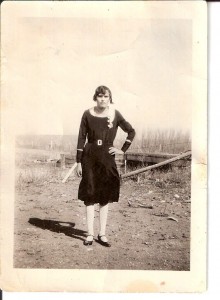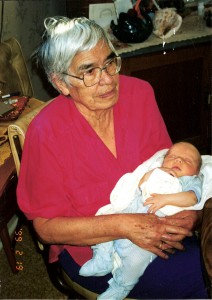
Cecilia LaRance was born in 1915 in a cabin on the South Fork of the Teton River. Her grandparents were among the Métis families who had settled along the Rocky Mountains between Heart Butte and Augusta in the late 1800s. Growing up in the distinct culture formed by the fusion of French, Scottish, Chippewa, and Cree heritages, Cecilia belonged to the last generation of children to experience the self-sufficiency and “old ways” of this Métis community.
The French Canadian LaRance family settled along the Rocky Mountain Front in the 1870s. Cecilia’s grandmother, Marguerite LaRance, was the first person buried at the Métis cemetery nestled in the trees along the South Fork. Cecilia’s father, James LaRance, was born at St. Peter’s Mission west of Fort Benton. When James was left with three small children after his first wife’s death, he married soft-spoken and hardworking Mabel Fellers, whose family had fled to Montana after the failed Northwest Rebellion of 1885.
The couple raised their family on a squatter’s homestead on Willow Creek, furnishing their single-room cabin with a woodstove, a large table, and apple-box benches. James’ rocker sat near Mabel’s sewing machine by the window. The cabin lacked electricity and indoor plumbing, and the LaRances bathed in a galvanized tub behind two chairs draped with a sheet for privacy. Cecilia and her sisters shared a bed, their brothers slept on a foldout sofa, and the baby’s hammock hung over the parents’ bed. When guests visited, they slept in the only space left: under the table. “We didn’t have room enough to keep a moth’s suitcase in that house,” Cecilia remembered.
Like other Métis families, the LaRances were self-sufficient. James LaRance was a trapper and woodcutter, supplying nearby communities with posts and poles that he traded for flour. Mabel sewed the family’s clothes. Each child had two outfits—one for school, one for everyday wear. Mabel showed Cecilia how to make soap by mixing rendered fat with homemade lye and pouring it into a shallow wooden box to set. She also taught Cecilia how to can vegetables—grown in plots along Willow Creek—and how to store roots and cabbages in a cellar for their winter supply.
The family kept a cow, a pig, and chickens. Gathering the eggs from their free-roaming chickens made Cecilia nervous, because snakes also lived among the bushes where the chickens nested. Her other chores included cleaning the chimneys of the kerosene lamps, scrubbing the wood floors, and helping wash the laundry by hand. Each evening, Cecilia and her siblings stocked the wood boxes and filled the water buckets from the creek.
In summer, Cecilia picked serviceberries, strawberries, rosehips, and gooseberries, which she and her mother made into jams. She helped her grandmother pound buffalo berries and chokecherries into flat dried fruit that would keep through the winter, sometimes mixing the mashed berries with dried meat to make pemmican.
For supper, the LaRances ate venison or “le rababou” (rabbit stew) with “lugalet” (bannock, a traditional Scottish flatbread), but Cecilia recalled that their lunches were often nothing more than lard on bread. One of her fondest childhood memories was the smell of newly made sourdough bread wrapped in a clean dishcloth and stored in the beer-crate-turned-breadbox.
Cecilia and her siblings found ways to earn money for things that had to be purchased. In the 1920s, Montana was attempting to eradicate coyotes and prairie dogs. The children drowned them in their holes and brought in the tails for bounty. The summer when she was twelve, Cecilia cooked full-time at a nearby ranch. She also herded a neighbor’s sheep and gathered wool that had caught in fences. On a rare trip to town, she could sell the sacks of wool for a little spending money.
Town was too far away for the Métis families to seek medical care, so in this, too, they were self-reliant. They mixed pine pitch with cottonwood buds, which contain an aspirin-like compound, to make an analgesic salve and used skunk grease (the boiled fat from skunks) to treat chest colds. Cecilia’s Chippewa-Cree grandmother gathered medicinal plants and tied each bundle of dried wild herbs with a different color of string according to its use.

Their relative isolation also kept most Métis families, who were Catholic, from attending church, although they maintained their religious traditions. Families gathered at one another’s homes to celebrate holidays, particularly New Year’s Day, when celebrations lasted a week or more or “until the fiddlers got tired out.”
Cecilia attended Bellview School, but to her regret, left school at fourteen. Her mother had attended Fort Shaw Indian School and then Chemawa Indian High School in Salem, Oregon, but Cecilia’s father was only educated through third grade. He insisted that his daughters needed no more than an eighth-grade education, and in 1931 Cecilia was married at sixteen to a man nearly twice her age that she had met at a Bellview dance.
The Métis families left their rural cabins in the 1930s, looking for work in nearby towns. The LaRances were one of the last families to leave, moving to Augusta in 1943 after losing their homestead to the Gleason ranch because they had never filed papers on it. By then Cecilia LaRance Wiseman had a family of her own and was working in town, but she missed her childhood in the country when “we’d spend our days just walking in the hills and sitting down and watching what was going on across the way. We were happy.” LKF
To learn more about the experiences of Métis women in Montana, read Brokers of the Frontier: Indigenous Women and the Fur Trade.
For resources and more reading suggestions, see the Bibliography of Resources about Native American and Métis Women in Montana and Métis Cultural Recovery Oral History Project—Bibliography.
Sources
Wiseman, Alfred. Interview by Melinda Livezey, February 10, 1994. Metis Cultural Recovery Project. Oral History 1659, Montana Historical Society, Helena.
Wiseman, Cecilia. Interview by Melinda Livezey and Al Wiseman, February 18, 1994. Oral History 1656, Montana Historical Society, Helena.
—. Interview by Melinda Livezey and Al Wiseman, March 1, 1994.. Oral History 1661, Montana Historical Society, Helena.
Grande, Irene Ford. Interview by Melinda Livezey, October 28, 1994. Oral History 1895, Montana Historical Society, Helena.
So interesting! Was Cecilia Al’s mother? Thank you! I want to revisit the Metis cemetery again.
Yes–this is Al Wiseman’s mother. Thank you for reading.
This story really surprised me. I didn’t notice the picture right away but surely recognized her when I put two & two together. If this is indeed Cecelia Wiseman then I knew her years ago when we both worked at the Teton County Courthouse. She was very soft spoken & didn’t smile much but was always friendly. That would have been in 1979, 1980. What a wonderful tribute. Thanks for whomever wrote this & thanks Julie for sending it to me.
My grandmother, Marie Bruno, was Cecelia’s oldest sister. I am so glad that this story of the Metis life from the early part of the 1900’s has been included in the Montana Women Project. I treasure the stories that my grandmother told me about her younger life. Wonderful writing for this story! Thank you.
Linda and Diane (and other readers): You are so welcome. I’m glad the story pleased you. It was a delight to learn about Cecilia Wiseman and to write about her childhood.
My sister just sent me a great picture of Ear Mountain with a row of mailboxes in the foreground. One of the names was Bruno and it made me think that the Bruno/Wiseman/LaRance families have been in the Teton Canyon for many, many generations. Thank you for refreshing my memory.
My great-grandmother was Marguerite Larance. My grandmother was Flora Christine Larance Lasarte. My mother was Lenore Lasarte. This is the first time I have ever read anything about my ancestors, and I am thrilled!
We are thrilled you found this. Please share it with your other relatives. You may also be interested to know that the Montana Historical Society has many interviews in its collection as part of its Metis Cultural Recovery Project. You can find a list here. https://montanawomenshistory.org/oral-history/bibliography/metis-cultural-recovery-oral-history-project-bibliography/
Copies of tapes, summaries and/or transcripts can be ordered from the Society’s research center.
Celcilia was my Great Aunt– Her Younger sister (my grandmother) Mary Rose Ringham is still alive at 92. She has shared many stories with us. I am very glad I got to know my family. What a great family it is with such rich heritage. I am using Great Grandma Mabel LaRance’s sewing machine to finish a quilt she started more the 60 years ago and never pieced or finished.
I would love to see any photos you have of our mutual kinfolk. My grandmother was Flora Christine LaRance Lasarte. Nobody in the immediate family has any photos or information, probably because most of us were adopted out. Only two sisters weren’t and they are pretty closed mouthed about everything or just plain don’t have any info. So excited to have a new cousin!
Gail ghuggard@msn.com
Love this story. I married into the LaRance clan so I am not blood relative but love doing geneolgy. Look forward into doing more research in this family.
Hi Darcey – do you have any old photos of the LaRance family? The only photo I have is one of my mother…most of us kids were adopted out. My bio grandmother was Flora Christine LaRance. I have found a ton of “new” cousins but they too were adopted out so nobody has any photos of our ancestors.
Mabel LaRance was my great grandmother…
Does someone knows Ruby m La Rance ??